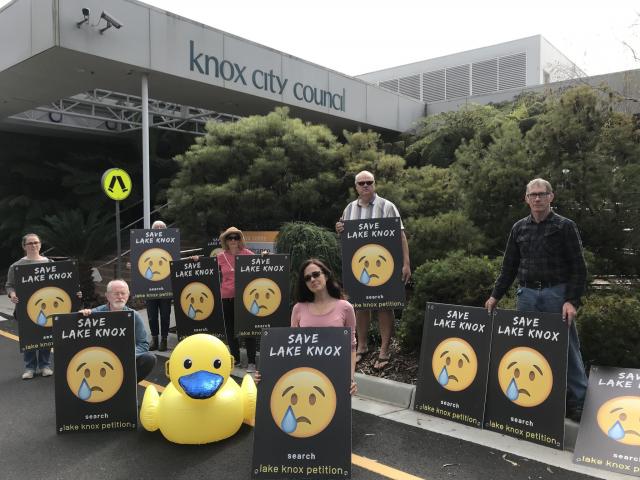
By Mikayla van Loon
The Lake Knox Victorian Civil and Administrative Tribunal (VCAT) hearing has been closed out, with the final submissions being completed in early December.
Now the involved groups await the final decision, after the tribunal postponed the subdivision hearing temporarily to determine a question of the law.
A decision by VCAT was handed down in September, determining Lake Knox does not fit the criteria of a waterway under the Knox planning scheme.
The question about whether the body of water was considered a waterway or dam under Melbourne Water’s characterisation was put forward by the Knox Environmental Society (KES) on day one of the VCAT hearing on 28 August.
Presiding member Tracey Bilston-McGillen and member Claire Bennett made the decision that Lake Knox could not be recognised as a waterway.
The rest of the VCAT hearing into the subdivision of the land by Development Victoria at 607-621 Burwood Highway Ferntree Gully could not continue until a determination was made by the tribunal.
“Having considered the submissions and evidence of the parties on the question of law, the Tribunal has determined that the waterbody on the subject land, referred to as the ‘dam’ or ‘Lake Knox’, is not a ‘waterway’ as defined under section 3(1) of the Water Act 1989 (Vic) (‘Water Act’) and therefore not a ‘waterway’ for the purposes of the Scheme,” the report read.
The which sits wedged between Burwood Highway, Scoresby Road and Blind Creek was referred to in the Habitat Creation and Management Plan as “the man-made dam”.
“[Where] the low point of the site connects to the adjacent waterway corridor being Blind Creek. The dam was built for water supply requirements relating to the previous land use being agricultural purposes.
“The dam currently provides a water storage function, with limited treatment of inflows. In addition to the subject site and overland flows, the dam captures significant stormwater runoff from a surrounding catchment of 28 hectares.”
The dam currently has a “storage capacity of approximately 31 ML” with overflows running into Blind Creek via the spillway pipes.
Under the Water Act, a waterway is defined by being a river, creek, stream or watercourse; a natural channel where water regularly flows; a lake, lagoon, swamp or marsh where there is a natural collection of water.
A dam “means anything in which by means of an excavation, a bank, a barrier or other works water is collected, stored or concentrated”.
Knox City Council’s submission to the tribunal supported the definition of the waterbody being a waterway based on “the land is regularly covered by water from a waterway”.
In the group’s submission, KES said it was “irrelevant that the water is collected in a constructed vessel (the dam)” in determining whether Lake Knox fell under the Water Act’s definition.
“Lake Knox is a natural collection of water. The evidence is that the water collects naturally,” the submission said.
“There is no suggestion or evidence that any other water other than rain/stormwater/Blind Creek water enters the Lake.”
Further submissions from Friends of the Glenfern Green Wedge, Richard Faragher, Sarah Dutton and Mattilde Hecker supported the submission from KES.
Melbourne Water however, said as the referral authority, it never “considered the waterbody to be a waterway”.
“The waterbody does not fall within that definition as it is not a ‘natural collection of water’ given the significant degree of the civil works which have been undertaken to create what is, in places, a 4m deep storage of water,” Melbourne Water’s submission said.
“The land has been excavated to allow for the collection and storage of water, and there exists a constructed embankment / barrier and spillway between the waterbody and Blind Creek.”
Development Victoria made similar arguments, stating “the method by which the water is collected at a point is not natural, water collects in the dam because the excavation and banks comprising the dam cause water to be collected”.
The submission from Development Victoria also outlined that because it owns the dam as a public statutory body, it cannot be considered a private dam.
Making the final decision, members Bilston-McGillen and Bennett found that Lake Knox did not fit any of the definitions of a waterway in the Water Act and said there was “no dispute that the waterbody meets the definition of a ‘dam’”.
“We do not consider the water delivery mechanism nor the water holding mechanism ‘natural’, therefore we find that the waterbody is not a natural collection of water,” they said.
“We also agree with Development Victoria and Melbourne Water that the consequences of not giving ‘natural’ its ordinary meaning are significant and problematic.”
The tribunal did not accept that there was a significant enough flow of water to constitute a current, that water collects regularly at the site, nor that the site is ‘regularly covered’ by water.
The VCAT hearing into the subdivision was still being heard in early December.






